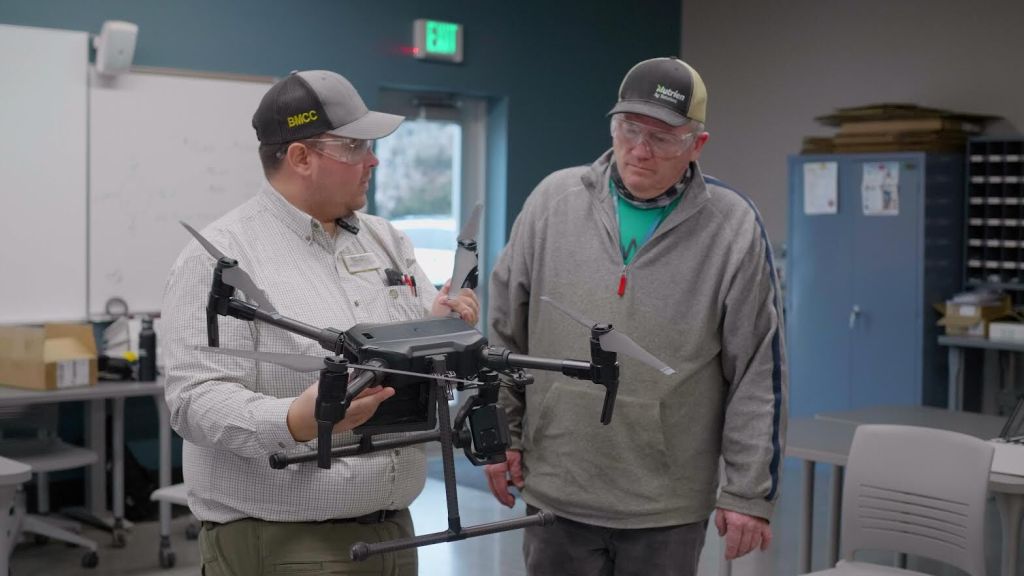Grant provides $30,000 for Blue Mountain Community College high-tech drone
Published 5:15 am Saturday, November 18, 2023

- Blue Mountain Community College Precision Agriculture instructor Andrew Leggett, left, and a student review the components of a DJI Matrice 200 drone with a thermal infrared sensor during a mission brief before a training flight in October 2019 in Hermiston.
PENDLETON — A high-tech agriculture program at Blue Mountain Community College will add to its arsenal of aerial imaging equipment thanks to a $30,000 grant from the Roundhouse Foundation.
Trending
Andrew Leggett, the college’s precision agriculture instructor, said the funding will help purchase a new state-of-the-art drone aircraft to survey crops, and it will come equipped with a multispectral sensor.
“There are several ways that can be used,” Leggett said, “but one of the biggest uses is in scouting. Traditionally, a farmer or an agronomist would walk out into a field, boots on the ground, looking for weeds or pests or other issues in the crop and later do something about it.”
Leggett said when working thousands of acres, the process can be very time consuming, and “there may be things you miss.”
Trending
“So one of the advantages of a drone has been to cover a large acreage in a much shorter amount of time,” Leggett said, “and the multispectral sensor sees light that’s visible, just like our eyes do, but it also sees a couple bands of light that our eyes cannot see. That would be the red edge, and especially the near infrared. That one tells us a lot of information about how healthy a plant is, or it can even help us distinguish between different species of plants.”
Leggett said the view of light in the red spectrum can help detect weeds.
“The flyover with the multispectral sensor makes a map of the field and then you’re looking for anomalies, spots in the field that look different from the rest of the field,” Leggett said. “You may have an idea of what’s causing the problem, but usually from the imagery alone, you don’t see the cause. So that’s where you do more targeted scouting on foot and investigate what’s going on.”
Leggett said the technology helps a farmer catch problem areas more reliably and sooner than going out and scouting with eyesight alone.
“A plant will start showing stress long before our eyes can see it,” Leggett said.
“There are people trying to correlate different values that come from the multispectral data such as how much nitrogen the crop needs,” Leggett said. “That specialized research is usually very specific to an area and specific crops. But like I mentioned, you can also use it to find weeds. So that’s something that I do with students in one of my courses.”
Leggett said he has a project where students map a small area and look for weeds and identify them from the imagery.
“Then we can create what’s called a prescription map that goes into a sprayer that we have, mounted on a little Kubota side-by-side vehicle controlled by GPS, so the Kubota actually steers itself,” Leggett said, “and then GPS will turn the sprayer on or off where weeds are. So students get a full circle.”
Leggett said the new drone is needed to keep his program technologically relevant.
“If we’re going to train students for what’s possible in the precision agriculture industry,” Leggett said, “we need to have the equipment they may encounter for them to get hands-on experience here at the college.”
Leggett said he has a good partnership with the Columbia Basin Agricultural Research Center, near Adams.
“A few years ago, I started collecting research data with drones for one of the researchers out there and it quickly turned into a student project,” Leggett said. “I have at least one student each year who would be the lead. I’m still there to make sure things get done, but I try to have students take the initiative to do most things. It’s usually a second-year student getting ready to graduate.”
Leggett said the grant funding will help BMCC buy an up-to-date drone with a sophisticated multispectral sensor and will improve his precision agriculture program significantly, but the school has been using drone flights for some time.
“Drone technology changes pretty rapidly, like phones, computers, and whatnot,” Leggett said. “Most of our drones are about four-five years old. Some of them are not produced anymore. So this was a way for us to keep the drone fleet up to date. We’re getting one of the newer drones on the market.”
The new sensor is able to pick up more bands of light than earlier versions, Leggett said.
“The previous ones would do five to six bands and this one can do 10,” he said, “so it’s giving the students access to the latest in technology out there and really giving them an edge.”
The Roundhouse Foundation, which is funding the grant, is privately held by a family in Sisters and “supports creative solutions to the unique challenges associated with rural culture and the landscapes of the Pacific Northwest,” according to its website.
{span} {/span}









